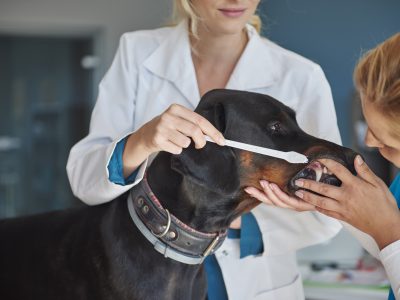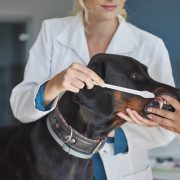Have you ever thought had bad it would be to be on a strict diet, of something you could barely stand, your whole life. We are not asking what three foods you would like on a dessert island, but more akin to eating bad hospital or airline food, the SAME exact dish, for EVERY MEAL.
Because this is what many dogs are subjected to, in the name of vet recommendations. We will counter this with why single ingredient animal meat dog treats, are one of the best and easiest ways to have it both ways – and keep you and your dog happy. More on that later.
Some people would say that they dislike the idea because it takes away freedom of choice.
It would make the food seem bland.
But more than that, it would also take away your joy of eating. One of the most simple basic pleasures any animal can have. I think that most people are well past the idea of considering that their dog is just an animal.
That most people know their dog to be sentient. That most journals say a ‘smart’ dog can have the cognitive abilities similar to a five-year-old human.
BUT did you know that feeding your dog the same or similar kibble / wet food for years is likely to have, very negative consequences of:
- Mid-term health
- Long term physical healthy (longevity) and mental well-being,
- AND specific to this article, atrophy of their taste buds
If you want to create a picky eater who is dissatisfied for life, just feed them the same meal, forever.
If you don’t want to do that, and instead what to make a happy healthy dog, we will give you some insight into the:
- Causes & symptoms
- Results of taste bud atrophy in dogs (and if it can be reversed)
What are dog taste buds REALLY about
Dogs like humans have taste buds on their tongues. Like humans there are different types of buds to detect different fundamental ‘tastes’
What dogs can detect: sweet, sour, salty, bitter, umami. AND WATER
What humans can detect: sweet, sour, salty, bitter, umami / savory
Here is an interesting factoid about why your dog beats you at taste. While humans have 9000 tastebuds compared to a dogs 1800, a dog prioritises different types.
For instance while dogs can detect sweet (and almost every animal loves sugar) carbs/ sugars are NOT good for dogs. They don’t need any food that supplies a sweet taste, but dog food companies often put sugar into dog food and treats, to addict dogs to the taste (disguising the fact there is little meat in it).
Humans often like mildly sour tasting foods. DOGS hate sour (it often tells them that a food is off and not to eat it).
While humans crave salty snacks – dogs tend to use this taste bud most when drinking the blood of their prey. They like the saltiness because they connect it with their survival (catching an animal).
While humans detect umami / savory tastes, dogs tend to just enjoy the Unami taste (because it is central to the taste of meat (Ie descending from a carnivore makes the enjoyment of umami a prime feature of a domestic dog).
When dog food or dog treats have a lack of meat in them (for corporate profit), they tend to add sugar and salt to the treat to at least give the dog something interesting to taste (and addict them).
Why does a dog detect water and a human doesn’t? What does water taste like? Curiously this type of taste bud was only identified in dogs recently, and it was found in the tip of the dogs tongue. It is believed that when a dog makes a prey kill, and drinks the blood for nutrients, that it also takes on a LOT of salt (that isn’t detected to the level that humans can)
So having a taste bud for a dog, that gives it ENJOYMENT from drinking water, is vital for its kidneys etc, to flush that extra salt from its body.
What does water taste like to a dog? Until they speak or proper brain scans are made, we may never know. But it kind of doesn’t matter, it serves an important function to have them stay hydrated and flush extra salt.
But here is the thing about taste bud atrophy. Dogs have exceptional smell. Around 10,000 times plus stronger that humans (when the brain nose sensor combination is factored in).
This has people think that taste buds are not very important, considering all the heavy lifting that their nose is doing. But if you already start off with a sensor that is greatly diminished in response (their taste), then dumb it down even further – then you are going to have some major issues elsewhere.
The importance of Taste Buds in Dogs:
- Nutrient Recognition: Having properly functioning dog taste buds, allows them to know which nutrient-rich foods are vital to eat. While smelling and tasting are connected, if you remove the ability to taste they will not specifically know what they are eating.
- Avoiding poisons and general Food Safety: being able to taste sour foods and what unami should taste like allows dogs to detect spoiled or harmful foods. This can prevent eating toxic substances. But also note, eating a lot of plant matter (ie little meat in dog food) creates a situation where the dogs stomach acid (when digesting) is a much more alkaline level than if they eat meat (acid).
A dogs stomach is meant to have high acid (low pH) much lower than humans, so they can digest raw meat even with some bad bacteria on it without getting sick. If you feed a dog a LOT of plant matter, they wont have that level of acid protection.
- Flavor Detection: This goes to the hear of taste bud atrophy – and what we will discuss below.
The causes, implications, and PREVENTION of taste bud atrophy
1 Causes of Taste Bud Atrophy
The same kibble OVER AND OVER. YOU control this. Vets and dog food companies recommend it. It ensures long term sales of a PRODUCT, and taste bud atrophy of your dog.
While dog foods are sold as whole and complete, NO single meal will have every nutrient that a specific dog requires for the whole of its life. This will lead to nutrient deficiencies, even if its just one of the ten essential amino acids in the main protein in their meal.
A dogs ageing process also changes their taste buds and what foods they enjoy
2 Symptoms of Taste Bud Atrophy
- Decreased appetite and weight loss
- Pickiness in eating
- Behavioral changes (as the lack of nutrients as well as boredom impacts them
- They will seek alternative foods (even some turning to Pica in dog parks)
3 Implications of Taste Bud Atrophy
Nutritional deficiencies as their enjoyment in food reduces. Any nutrients missing in a single kibble might also cause: anaemia, a weakened immune system and poor coat health.
Quality of Life: reducing their enjoyment of food and daily activities. Overall wellbeing and life satisfaction is greatly diminished.
Digestive Issues: reduced dietary variety can also impact gut health.
Most people and scientists are understanding how the gut might be the second most important organ in a species next to the brain.
Because different foods create a diverse dog gut microbiome, it is a resilient one too. A monotonous diet can lead to digestive problems, including constipation or diarrhea. As well as infection and all of the other side effects that humans experience. The only thing is, that a dog can’t tell you when it is feeling sick in the stomach/ bowel.
4 Preventing Taste Bud Atrophy
This should be a no-brainer,
The issue is that many people go about it the wrong way.
Dog food manufacturers tell you to feed the same kibble for a year or two, then upgrade to a more expensive one they have and stay on that etc. They are about shifting units.
The two best ways of reducing taste bud atrophy in dogs is diversity of food.
1 Raw feeders
They regularly rotate the meat and plant matter and many supplements they feed their dogs. Contrary to what dog food makers try and tell you that consistency is key, DIVERSITY is much healthier.
If you don’t have time or desire for the big learning curve on making your own dog food, at least varying between several varieties of dog kibble, and wet foods each week, plus occasional cans of tuna or chicken breast and rice would go a long way towards the variety your dog actually craves.
Another great alternative if you are a commercial dog food feeder, and don’t like the idea of raw feeing for whatever reason, is to use dried meat-based dog treats. And in particular if you use a meat treat that takes a very long time for them to eat.
Your dog will both get long lasting enjoyment as well as you want have to reduce their kibble that much, because they are only eating a small amount of other food. That is where a long-lasting treat like bully sticks can play an important role in keeping a dog’s taste buds active.
2 The addition of meat based dog treats
For those wanting to remain on the one kibble their vet told them to buy, or the only one that their dogs seem to like eating, there is a great compromise.
One that ADDS to your dog’s life, life expectancy, and enjoyment of life.
Dog food is typically much lower than 50% meat and offal. Its just a cost thing.
Dogs need and crave animal-based protein. If your dog has a sensitive stomach, or is very young, old or pregnant, or has a chronic illness, you might feel it too risky to feed raw meat or offal to them.
And chances are that if you are coming from the 90% of the population that feeds a sanitised highly processed commercial dog food, you won’t want to change, just based on this one article.
We recommend not just feeding your dog any dog treats (i.e. plant based that just gives more filler carbs), but dried animal based single ingredient treats, that give vitality and taste to your dog (and their taste buds).












Comments